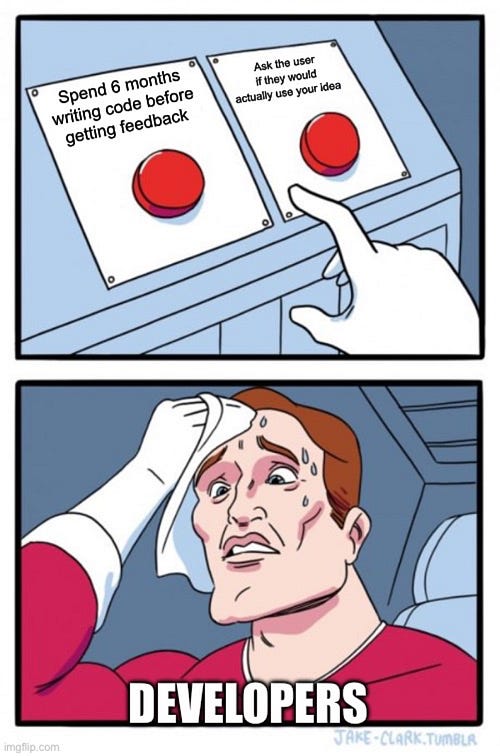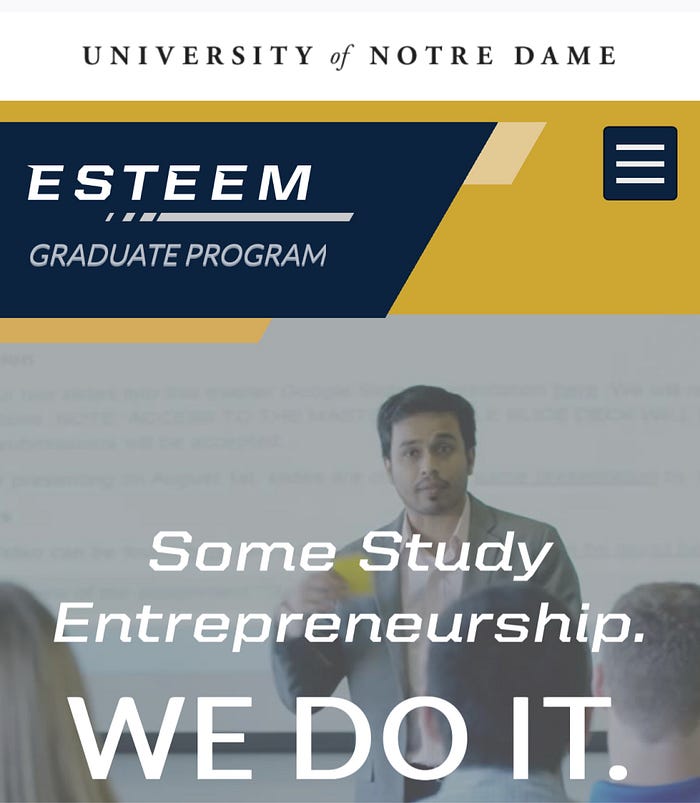Don’t Forget to Ask the Customer Before, During, and After

I just wanna put this out as a PSA that you should be writing and making products that work well AND they solve a end user frustration.
Seems stupid to say this until your realize how easy it is for a project at work to carry on 6 month ( or even years!!! ) without getting substantial and valid criticism and feedback.
Good examples that always get touted as products that fit the market need are Uber, Slack, Tesla, and Zoom. Examples of products that failed because of timing or lack of market value after lots of money and effort thrown at it are New Coke, Google Glass, Microsoft Zune, and Kodak.
Masters of Entrepreneurship at The University of Notre Dame
For my masters degree, I went to the University of Notre Dame. I was in the ESTEEM program, which had the long name of engineering, science, and technology entrepreneurship excellence masters. well the name may be very long, it was essentially a side step away from the business program. It was amazing for many different reasons, but the one thing that really stuck home was the motto, “Build things that matter”.

During that masters program, we took on various projects, and one of them required 50 and user interviews. And my case I ended up working with a company that was in healthcare and cyber security, and because of that I had to reach out to 50 people in that space. I was tracking on people on LinkedIn and anyone that would talk to me that had experience as a CTO or CISO for interviews about what their needs and pains were, and how my potential ideas could help.
We then would take this and begin to merge the feedback we got with the original idea of the business to make a better and more targeted idea. Eventually we would execute on the idea, either by created the rough business plan and even creating prototypes that could be rolled into further development.
I ended up making a really cool idea that the company later that year started to roll with. And I’m super proud of the fact that even though I had no experience with cyber security and no experience with healthcare, I was able to really get something that was grounded and that worked. I’m really appreciative that I learned from a year of experience on how entrepreneurship works. It’s grit and scrappiness to go figure out things that you didn’t know before, but then also to realize that you’re making something that needs to be bought and desired. The best way to do that is to go ask the user do they want what you’re making.
Corporate Blinders
No one likes to feel like their work is an important. But we also want to feel like we have a secure job that will continue for the next foreseeable future, if we choose to work there. Often times are bigger the company, the more side projects and deep dives into technology there is.
I am discovering little by little that the same lessons I learned at the ESTEEM program are still just as applicable to a master student as they are to a software developer. As a developer you have multiple “customers” you have to satisfy:
-
The Customer — they might be on the company, they might be on the other side of the world paying $2 for your business micro transactions. They needs to buy the product and hopefully keep buying.
-
The business — its bottom line is profit. Can your work efforts bring profit? Sadly, we all are cogs in someone’s wheel.
-
Your manager — They need to prove to the business that they are bringing profit and value because of their ideas, management, project, and team. Great managers are a delight to work with/ for. Sucky managers drag you down with their own inability to align incentives and see the bigger picture.
-
Your team — they need to prove that they provide value themselves and keep their job. They are looking for workplace satisfaction and a paycheck just as much as you are. Uplift them as you watch out for your own interest.
The “customer” is always a dynamic term depending on perspective. You will have to satisfy/ delight the customer if you want to keep a job, build a team, or sell your product. Keep that in mind.
The customer is always right in matters of taste
You might have the know how to build something, but the customer should have a say in the what.
Remember to look up every once in a while from the corporate requirements and ask yourself, how’s the actually helping the end customer?
Okay, but how?
I guess that’s kind of the beauty entrepreneurship is there’s no one right way to do anything. I don’t know your job, I don’t know your project, and I don’t know what your workplace environment looks like.
Hear the basics:
-
Ask yourself how can I deliver value? If that value is completing a bunch of Jira tickets, that’s great. If you’re starting a Greenfield project, be sure to ask the customer where they actually want to use this. And also ask them.
-
Beware of the XY problem. Sometimes customers say they want one thing, but they really want another. This takes a little bit of experience to see, but you’ll notice it when in the beginning of projects you don’t have something totally firm down or the customers are describing a problem they think they have. One of the most famous characterizations of this is when Ford said, “If I had asked people what they wanted, they would have said faster horses.”
-
In the beginning, iterate quickly and be unafraid to change or start over. Make a low fidelity demo (think figma, balsamiq, ugly react app, scraps of paper with labels) that you can make an iterate quickly over. Ideally, if you can do it within a day and get feedback from your end-user in a day, you doing something right.
-
Get customer and stakeholder buy in. You can have the best idea in the world that solve someone’s problem, but if you can’t explain the idea, well, you won’t get far.
-
What venture funds look for is the Right Team, the right Market, and the right Timing. managers will look for the same things, whether they know it or not. Do you have the right skill set to get things done, are you trying to address a problem that is worthwhile, and do you have enough time and timing to get it done?
Conclusion
I hope some of these ideas help you in your next engineering project. I’ve seen firsthand how thinking like an entrepreneur can elevate your career and bring energy back into your work. Heck, you might even want to go be a solo entrepreneur after this ha ha